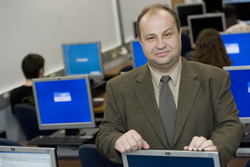Obradovic mines mountains of data for hidden treasure
Faculty Research Award
 Photo by Ryan S. Brandenberg/Temple University
Professor of computer and information sciences Zoran Obradovic will receive a Faculty Research Award for his vast body of work in bioinformatics.
|
In the days of the California Gold Rush, miners would sift through pounds and pounds of dirt, looking for that one gold nugget.
These days, Zoran Obradovic is the 21st century’s answer to those forty-niners: he sifts through piles of information — data mining — to look for specific trends. “We collect large amounts of data to better understand why something is happening,” said Obradovic, a professor of computer and information sciences in the College of Science and Technology. “There could be something going on that is present in a number of different research studies, but is often overlooked because it isn’t relevant to what that particular researcher is looking for. Looking at a bigger picture across a large amount of data helps us recognize these trends.” |
|
|
|
|
Obradovic’s laboratory conducts advanced knowledge discovery studies that include summarization, trend analysis, anomaly detection, clustering, prediction, text, image and stream mining. He has worked with investigators across several colleges and schools at Temple, on projects from pollution concentration to crime rates among Philadelphia youth, and is constantly on the lookout for ways to establish new interdisciplinary research collaborations. But it is his work in bioinformatics that is world renowned; his research on disordered proteins — those that bind in unusual ways — was the first of its kind, and dispelled a common school of thought for most of the 20th century, which was that proteins are structurally rigid and fit together like a lock and key. Obradovic’s impressive body of work has earned him this year’s Temple University Faculty Research Award. Prior to joining Temple’s faculty in 2000, Obradovic was a professor at Washington State University. While there, he heard a talk given by a scientist from a pharmaceutical company in which flexible protein structure was considered an exception to the rule. “I had read in Nature about another study that found disordered proteins to be an exception to the rule,” said Obradovic. “I started to wonder who else had looked at these ‘strange’ proteins, and if they were in fact an exception or the new rule? “There was a big surprise when, through data mining studies, we found that disordered proteins are very common in nature,” he said. “We’ve found that many of these proteins have associations with cancer and other diseases.” Obradovic’s work has served as a jumping off point for many other researchers in the field, and has led to the birth of a subspecialty in protein disorders, an area which is young but now booming. While at Washington State, he was named Researcher of the Year by the College of Engineering and Architecture. He received his bachelor’s in applied mathematics and master’s in mathematics and computer sciences from the University of Belgrade, and his Ph.D. in computer science from Penn State University in 1991. Even though Obradovic has authored nearly 200 scholarly publications and his research has been consistently funded by the National Institutes of Health for more than 10 years, he says his research is far from over. “Every time one question is answered, it always raises several more,” he said. |
|